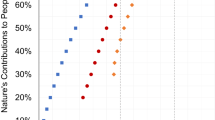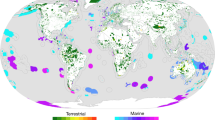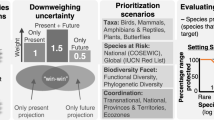Abstract
In light of continuing global biodiversity loss, one ambitious proposal has gained considerable traction amongst conservationists: the goal to protect half the Earth. Our analysis suggests that at least one billion people live in places that would be protected if the Half Earth proposal were implemented within all ecoregions. Taking into account the social and economic impacts of such proposals is central to addressing social and environmental justice concerns, and assessing their acceptability and feasibility.
This is a preview of subscription content, access via your institution
Access options
Access Nature and 54 other Nature Portfolio journals
Get Nature+, our best-value online-access subscription
$29.99 / 30 days
cancel any time
Subscribe to this journal
Receive 12 digital issues and online access to articles
$119.00 per year
only $9.92 per issue
Buy this article
- Purchase on Springer Link
- Instant access to full article PDF
Prices may be subject to local taxes which are calculated during checkout

Similar content being viewed by others
Data availability
The datasets used in this study are all publically available or available to educational institutions for non-commercial purposes, but not distributable by the authors. Details of each dataset and download links are provided in the Supplementary Information.
Code availability
The R code used to reproduce the results is provided in the Supplementary Information.
References
The Strategic Plan for Biodiversity 2011–2020 and the Aichi Biodiversity Targets (CBD, 2010).
Tittensor, D. P. et al. A mid-term analysis of progress toward international biodiversity targets. Science 346, 241–245 (2014).
Global Assessment Preview (IPBES, 2019).
Locke, H. Nature needs half: a necessary and hopeful new agenda for protected areas in North America and around the world. George Wright Forum 31, 359–371 (2014).
Wilson, E. O. Half-Earth: Our Planet’s Fight for Life (Liveright, 2016).
Dinerstein, E. et al. A global deal for nature: guiding principles, milestones, and targets. Sci. Adv. 5, eaaw2869 (2019).
Synthesis of Views of Parties and Observers on the Scope and Content of the Post-2020 Global Biodiversity Framework (CBD, 2019).
Dinerstein, E. et al. An ecoregion-based approach to protecting half the terrestrial realm. BioScience 67, 534–545 (2017).
Mehrabi, Z., Ellis, E. C. & Ramankutty, N. The challenge of feeding the world while conserving half the planet. Nat. Sustain. 1, 409–412 (2018).
Ellis, E. C., Pascual, U. & Mertz, O. Ecosystem services and nature’s contribution to people: negotiating diverse values and trade-offs in land systems. Curr. Opin. Environ. Sustain. 38, 86–94 (2019).
Brockington, D. & Wilkie, D. Protected areas and poverty. Philos. Trans. R. Soc. B 370, 20140271 (2015).
Oldekop, J. A., Holmes, G., Harris, W. E. & Evans, K. L. A global assessment of the social and conservation outcomes of protected areas. Conserv. Biol. 30, 133–141 (2016).
West, P., Igoe, J. & Brockington, D. Parks and peoples: the social impact of protected areas. Annu. Rev. Anthropol. 35, 251–277 (2006).
Büscher, B. et al. Half-Earth or whole Earth? Radical ideas for conservation, and their implications. Oryx 51, 407–410 (2017).
Kopnina, H. Half the earth for people (or more)? Addressing ethical questions in conservation. Biol. Conserv. 203, 176–185 (2016).
Venter, O. et al. Sixteen years of change in the global terrestrial human footprint and implications for biodiversity conservation. Nat. Commun. 7, 12558 (2016).
World Database on Protected Areas (UNEP-WCMC & IUCN, 2018); https://protectedplanet.net
Bright, E. A., Rose, A. N., Urban, M. L. & McKee, J. LandScan 2017 High-Resolution Global Population Data Set (Oak Ridge National Laboratory, 2018).
Balmford, A. et al. Conservation conflicts across Africa. Science 291, 2616–2619 (2001).
Visconti, P., Bakkenes, M., Smith, R. J., Joppa, L. & Sykes, R. E. Socio-economic and ecological impacts of global protected area expansion plans. Philos. Trans. R. Soc. B 370, 20140284 (2015).
Ten Brink, B. et al. Rethinking Global Biodiversity Strategies: Exploring Structural Changes in Production and Consumption to Reduce Biodiversity Loss (Netherlands Environmental Assessment Agency, 2010).
Database of Global Administrative Areas (GADM, 2018) https://gadm.org/
Country Classification (World Bank, 2018).
ArcGIS for Desktop v.10.4.1 (ESRI, 2016).
R Core Team R: A Language and Environment for Statistical Computing (R Foundation for Statistical Computing, 2018).
Acknowledgements
J.G.Z. undertook this work while a Visiting Scholar in the Department of Geography, University of Cambridge (May 2018–April 2019), and was supported by the Swiss Programme for Research on Global Issues for Development (r4d programme), which is funded by the Swiss National Science Foundation and the Swiss Agency for Development and Cooperation (grant no. 400440 152167). Our analysis was conducted utilizing the LandScan (2017) high resolution global population data set copyrighted by UT-Battelle, LLC, operator of Oak Ridge National Laboratory under Contract No. DE-AC05-00OR22725 with the United States Department of Energy.
Author information
Authors and Affiliations
Contributions
J.S., J.G.Z., C.F., B.V., P.V. and C.S. designed the analyses. J.S. and J.G.Z. compiled the data and conducted the analyses. J.S. wrote the paper with input from J.G.Z., C.F., B.V., P.V. and C.S.
Corresponding author
Ethics declarations
Competing interests
The authors declare no competing interests.
Additional information
Publisher’s note Springer Nature remains neutral with regard to jurisdictional claims in published maps and institutional affiliations.
Supplementary information
Supplementary information
Supplementary Figs. 1–3, methods, notes and references.
Rights and permissions
About this article
Cite this article
Schleicher, J., Zaehringer, J.G., Fastré, C. et al. Protecting half of the planet could directly affect over one billion people. Nat Sustain 2, 1094–1096 (2019). https://doi.org/10.1038/s41893-019-0423-y
Received:
Accepted:
Published:
Issue Date:
DOI: https://doi.org/10.1038/s41893-019-0423-y
This article is cited by
-
Contributions of human cultures to biodiversity and ecosystem conservation
Nature Ecology & Evolution (2024)
-
Nature’s contribution to poverty alleviation, human wellbeing and the SDGs
Scientific Data (2024)
-
Participatory monitoring drives biodiversity knowledge in global protected areas
Communications Earth & Environment (2023)
-
Community forest governance and synergies among carbon, biodiversity and livelihoods
Nature Climate Change (2023)
-
Including stewardship in ecosystem health assessment
Nature Sustainability (2023)



